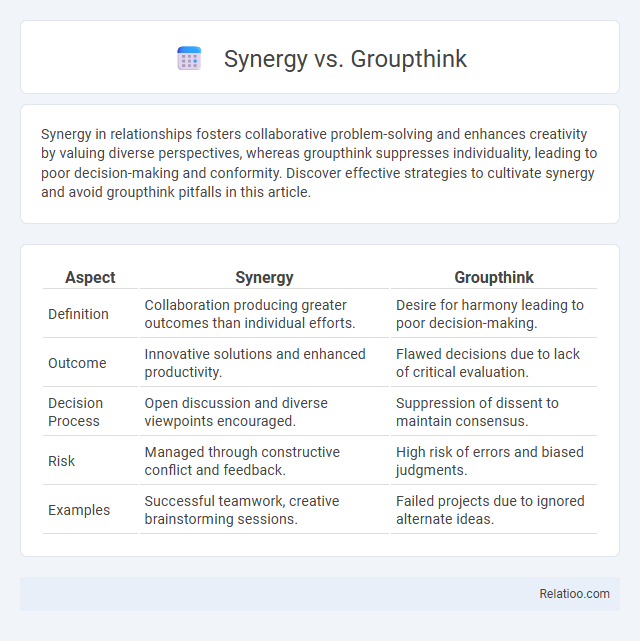Synergy in relationships fosters collaborative problem-solving and enhances creativity by valuing diverse perspectives, whereas groupthink suppresses individuality, leading to poor decision-making and conformity. Discover effective strategies to cultivate synergy and avoid groupthink pitfalls in this article.
Table of Comparison
| Aspect | Synergy | Groupthink |
|---|---|---|
| Definition | Collaboration producing greater outcomes than individual efforts. | Desire for harmony leading to poor decision-making. |
| Outcome | Innovative solutions and enhanced productivity. | Flawed decisions due to lack of critical evaluation. |
| Decision Process | Open discussion and diverse viewpoints encouraged. | Suppression of dissent to maintain consensus. |
| Risk | Managed through constructive conflict and feedback. | High risk of errors and biased judgments. |
| Examples | Successful teamwork, creative brainstorming sessions. | Failed projects due to ignored alternate ideas. |
Understanding Synergy: Definition and Benefits
Synergy occurs when the combined efforts of a group produce a result greater than the sum of individual contributions, leading to enhanced creativity and problem-solving. Unlike groupthink, which suppresses dissent and critical thinking, synergy encourages diverse perspectives and constructive collaboration. Effective teamwork fosters synergy by leveraging complementary skills and promoting open communication, resulting in improved productivity and innovative solutions.
What is Groupthink? Key Characteristics
Groupthink is a psychological phenomenon where the desire for harmony in a decision-making group leads to irrational or dysfunctional outcomes, suppressing dissenting viewpoints to maintain consensus. Key characteristics include an illusion of invulnerability, collective rationalization, belief in inherent morality, stereotyped views of outsiders, self-censorship, direct pressure on dissenters, and the presence of a mindguard who protects the group from opposing ideas. Understanding groupthink is critical for preventing poor decisions and fostering an environment of open communication within teams.
Distinguishing Synergy from Groupthink
Synergy occurs when individual strengths combine to produce a result greater than the sum of their separate effects, promoting innovation and effective problem-solving. Groupthink, in contrast, suppresses dissent and critical thinking, leading to poor decision-making and conformity pressures that hinder creativity. Understanding these differences helps you foster teamwork that encourages diverse perspectives while harnessing collective intelligence for optimal outcomes.
The Psychological Foundations of Group Decision-Making
Synergy arises when group members' diverse skills and perspectives combine to produce superior outcomes beyond individual efforts, driven by constructive conflict and open communication. Groupthink undermines effective decision-making by fostering conformity and suppressing dissent due to social pressure and the desire for harmony within cohesive groups. Teamwork depends on mutual trust, shared goals, and collaborative problem-solving, leveraging individual cognitive diversity to enhance collective intelligence and informed decision-making.
Positive Outcomes of Synergy in Teams
Synergy in teams generates enhanced creativity and problem-solving by combining diverse skills and perspectives, leading to superior outcomes compared to individual efforts or conventional teamwork. Unlike groupthink, which stifles innovation through conformity, synergy fosters an open exchange of ideas that drives innovation and adaptability. Effective synergy results in increased productivity, stronger collaboration, and higher team morale, contributing significantly to organizational success.
Negative Consequences of Groupthink
Groupthink often leads to poor decision-making because it suppresses individual opinions and critical thinking, resulting in conformity pressure within the group. Teamwork encourages diverse perspectives and collaborative problem-solving, while synergy maximizes the combined strengths of team members to produce outcomes greater than individual efforts. Understanding these differences helps you avoid the negative consequences of groupthink, such as reduced creativity and flawed consensus.
Real-World Examples: Synergy vs Groupthink
Synergy occurs when a team combines diverse skills and perspectives to achieve superior results, exemplified by Apple's innovation in product design, where collaboration across departments creates groundbreaking technology. In contrast, groupthink appears in the Challenger space shuttle disaster, where NASA engineers suppressed dissenting opinions, leading to flawed decision-making and tragedy. Effective teamwork fosters an environment that encourages synergy and avoids groupthink by promoting open communication and valuing individual contributions.
Strategies to Foster Synergy and Avoid Groupthink
Fostering synergy requires implementing strategies that encourage diverse perspectives, open communication, and collaborative problem-solving, ensuring each team member's unique contributions are valued. To avoid groupthink, your team should promote critical thinking, invite constructive dissent, and establish a culture where questioning ideas is safe and encouraged. Emphasizing these approaches enhances teamwork effectiveness by balancing innovation with thorough evaluation of options.
The Role of Leadership in Team Dynamics
Effective leadership shapes team dynamics by fostering synergy, where individual strengths combine to create superior outcomes beyond the sum of parts. Leaders who encourage diverse perspectives prevent groupthink, promoting critical thinking and innovation. By balancing guidance and collaboration, leadership cultivates teamwork that aligns goals, enhances communication, and drives collective success.
Building a Culture of Collaboration and Critical Thinking
Building a culture of collaboration and critical thinking requires understanding the distinctions between synergy, groupthink, and teamwork to optimize collective performance. Synergy emerges when diverse team members bring unique perspectives, enabling creative solutions that surpass individual contributions, while groupthink stifles innovation by promoting conformity and suppressing dissenting views. Your organization thrives by fostering open dialogue and encouraging critical analysis, ensuring teamwork evolves into a dynamic process where collaboration drives effective decision-making and continuous improvement.

Infographic: Synergy vs Groupthink
 relatioo.com
relatioo.com